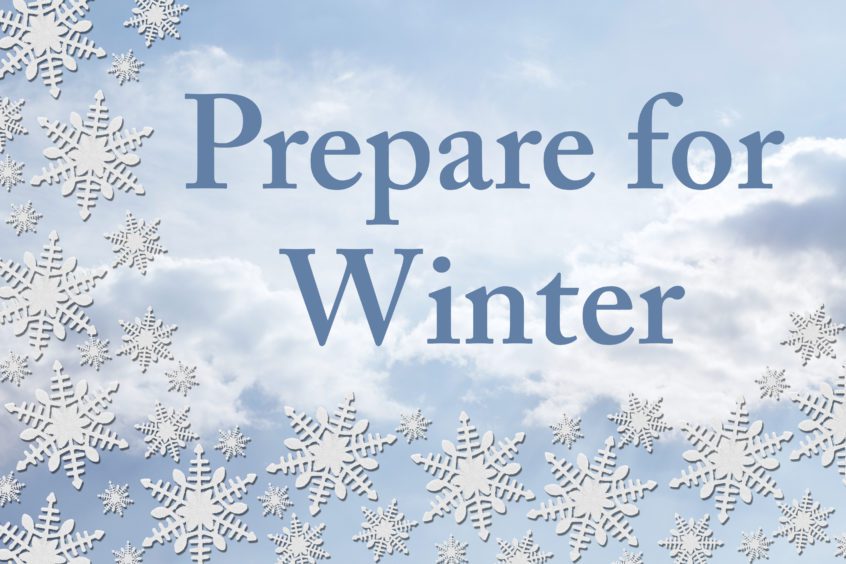You’ve enjoyed your outdoor living spaces all summer as you hosted barbecues, played with your children or grandchildren, and planted beautiful flowers and tasty fruits and vegetables. Now that winter is approaching, give your outdoor spaces some TLC. If you follow these tips to winterize, your outdoor living spaces will look great all winter and will remain in great shape when spring arrives.
Winterize Wooden Structures
Wooden Decks
- Remove all furniture, planters, outdoor kitchen equipment, etc.
- Clean off and sweep the deck.
- After sweeping, you may need a deeper clean with a warm, soapy solution and soft bristle brush. If mold is visible use an oxygen bleach solution. Apply and wait thirty minutes before rinsing.
- Inspect for damage, loose boards, or nails, and make any necessary repairs.
- Apply a water-repellent finish
- Continue to sweep leaves and debris from your deck regularly in the fall.
Note: It’s best to keep the snow cleared from the deck throughout the winter months. Routinely clear snow to minimize damage and fading from prolonged contact with snow and ice. Otherwise, when the snow melts it will send the moisture right into the wood. A blower is preferred, but when shoveling, push snow with the planks instead of against to avoid scarring wood with an aggressive shoveling technique. Avoid using salt or other ice melting products on a wood deck to reduce damage.
Pergolas:
Sweep the floor and remove all leaves and debris. Scrub away the mold and mildew. Check for loose screws, nails, etc, and repair as needed. This will prolong your pergolas lifespan and prevent any repairs in the future.
Winterize Rain Gutters
The next step to winterize your outdoor spaces is to clean out your gutters.
Ensuring water flow freely through your gutters will help prevent icicles and ice dams from forming during winter storms. A clogged rain gutter system can send a cascade of water down the side of your house, making canyons in your flowerbeds and saturating your foundation.
Clean gutters of leaves and debris to help prevent damage to your landscaping and siding, and to head off expensive water damage repairs to your foundation that may cost $10,000 or more.
Use a sturdy ladder to assist in reaching the gutters. Use a scoop to help clean out the debris. Laying a tarp under you to drop the sludge onto will prevent damage to your lawn and make for a quick clean up afterwards. Wear rubber gloves to protect your hands during the process.
Prepare Flower Beds and Gardens
Here’s a look at what you can do in the garden this season to winterize your garden and flowerbeds.
- Clean the garden and flower beds. Pick up leaves, acorns, twigs, clippings, and garbage. Pick up fallen fruit. Remove dead annuals. Cut back spent perennials. This gives the garden a neater appearance and may reduce the chance of pests making themselves and home in the debris and causing problems next year. Also, while it’s good to cut back some perennials, some can be left in place. These include ornamental grasses and thick-stemmed plants such as Russian sage, taller sedums, and mums.
- Add color to brighten up the dark winter. Plant hardy fall and winter flowers such as pansies and mums and foliage plants such as ornamental kale. They’ll flourish in the cooler temperatures and even stand up to frost. They’ll add a much-needed burst of color to your outdoor space.
- Plant Bulbs. Fall is the time to plant spring-blooming flower bulbs such as crocus, hyacinth, grape hyacinth, daffodils, and tulips. Garlic and shallots can be planted now for harvest next summer.
- Protect plants from grazing animals. Surround valuable shrubs and trees with hardware cloth to prevent animals grazing on foliage.
- Keep plants moisturized. Just like your skin can dry out in the winter, plants can have a hard time retaining their moisture as well. Make sure plants are well watered going into the winter months. Consider spraying with an anti-desiccant (Anti-desiccants are products that can be applied to evergreen trees and shrubs to help hold in moisture through the winter. If you have problems with cold damage in your garden, you may want to give them a try.) Or you can try wrapping plants with a double layer of burlap.
- Protect those prized rosebushes. In colder/harsher locations, use rose cones or make a cylinder of your own and fill with chopped leaves for the winter. Remove in early spring.
- Add mulch. Add a protective layer of mulch to your flower beds and gardens after the first hard freeze. This will keep the soil at a more even temperature.
- Prepare gardening tools. Clean and sharpen garden tools before putting them away. Disconnect and drain hoses before storing them for them winter.
Winterize Trees
- Walk around and inspect trees. Once the leaves have fallen from the trees it is time to begin inspecting them for pruning. Look for trees that are old, appear weakened or diseased. Also check for any dead branches, particularly those hanging near or over your home, driveway, and carport. Snow accumulation could be enough to bring a diseased tree or branch down. You can eliminate this risk by removing any dead trees or branches now before the first snow fall. This article can tell you more about which branches to consider pruning from trees for aesthetics, growth, and safety.
- Wrap tree trunks to avoid frost cracking. This prevents damage to thin-barked species in winter when sun-warmed sap quickly freezes at nightfall and causes bark to split. Use paper tree wrap, starting an inch below soil level and up to the lowest branches. Adhere with duct tape. Remove in spring to allow new growth.
Winterize Outdoor Plumbing
Frozen or burst pipes are the last thing you will want to experience during the winter.
Winterize your outdoor plumbing by following these steps:
- Flush out the water
- Remove hoses and drains
- Add winterizing chemicals to pools and water features that you don’t intend on completely draining.
- Make notes of any cracks or problems you notice with your outdoor water features, and take care of them as soon as possible.
Faucets
- Use the shut-off valve to shut off outdoor faucets.
- Drain exterior faucets – Turn on all faucets to drain any water left in them. If the water continues to flow, check the valve to make sure it’s off. Leave the faucet handle turned on throughout the winter.
- Add protection – Insulate all exterior pipes with pipe insulation. These insulation sleeves fit right over existing pipes and can be purchased at your local hardware or home improvement store. Also winterize outdoor faucets with an insulated faucet cover to give added protection to your faucet
Winterize Your Lawn or Artificial Turf
- Remove fallen leaves and debris like acorns and twigs. You can do this by raking and bagging the leaves or by mulching them with your lawn mower.
- Remove weeds. Pull weeds by hand, or spray them so they don’t get a chance to develop roots between freezes.
- Aerate. You can use a manual aerator or rent power equipment.
- Spread compost. Fall rains will help work the beneficial microbes and nutrients further into the soil.
- Reseed bare spots. Scratch the surface to loosen soil, sprinkle grass seed, and cover lightly with straw or other mulch. Keep the seed watered until the grass is established.
- Apply a winter-specific fertilizer.
- Continue to water until frost is imminent if the fall has been dry. Moisture in your lawn will prevent snow mold and blight pathogens
Artificial Turf Lawn Replacement
If you have an artificial turf lawn, have your turf professionally groomed to remove debris and fluff the blades. Grooming keeps your turf looking as good as the day it was installed and helps to prolong its lifespan.
Or if you have been considering replacing your sod with artificial turf, the fall is a great time to do so as it is the off-season.
Winterize Outdoor Furniture
It’s best to store furniture and cushions indoors to prevent snow accumulation or cover them with a water-resistant material to prevent damage from the elements. Before storing or covering outdoor furniture and other accessories for the season, give the items a good cleaning to remove dirt and grime.
Fire pits, Chimineas, Brick Ovens
- Gas, propane, and wood burning fire pits chimineas, and brick ovens all need to be winterized.
- Make sure to clean out the ashes and remaining wood. Pits that use propane should have the tank detached. Portable tanks should be stored in a garage, shed, or storage building away from the house.
- Make sure there is sufficient drainage for your fire pit to prevent water freezing within and causing damage.
- The next step is to cover the pit or chimenea opening. The best option is with a fitted cover.
- Keep brick oven and fireplace doors closed to prevent snow and ice from building up inside the unit.
Winterize Your Outdoor Kitchen
Clean Your Grill:
- Thoroughly clean the racks of your grill with a grill brush
- Apply a coat of cooking oil to the burners and other metal parts to repel moisture and prevent rust.
- Burn off the last of the gas.
- Remove the tank from a propane grill and store outdoors, away from the house in a garage, shed, or storage building.
- Tape a plastic bag over the gas line opening to keep animals from nesting there.
- Cover with a heavy-duty vinyl to keep it safe and dry.
Winterize sinks and appliances:
- Shut off water to your outdoor kitchen.
- Drain all water lines. Leave the drain valves open.
- Turn off the power to appliances.
- Clean the inside of appliances and cabinets. Wipe everything down to remove residual moisture.
- Do not cover outdoor refrigerators or ice makers as a cover could collect moisture and cause electrical damage.
- Cover sinks to prevent debris from collecting in the basin.
Winterize Planters
Like all garden beds, planters need protection during the winter months.
- Before the first freeze, move plants that can be easily transplanted indoors.
- Outdoor planters that are too big to bring inside can be wrapped with a heavily insulated material, like burlap, and moved to an area of the space that will allow them to still get enough direct sunlight.
Taking the time to winterize your outdoor living space now will not only protect your investment, but it will also give you peace of mind, knowing that your decorating and designing efforts made during the warmer months will not go to waste because of harsh winter elements. And as an added bonus you’ll minimize your spring maintenance and have a jump start of the enjoyment of your first warm weather gathering.
If the winterizing tasks sound too daunting for you, give Golf Greens Texas a call and we will winterize your outdoor living spaces for you. Just ask for our special Fall Clean Up Services!







